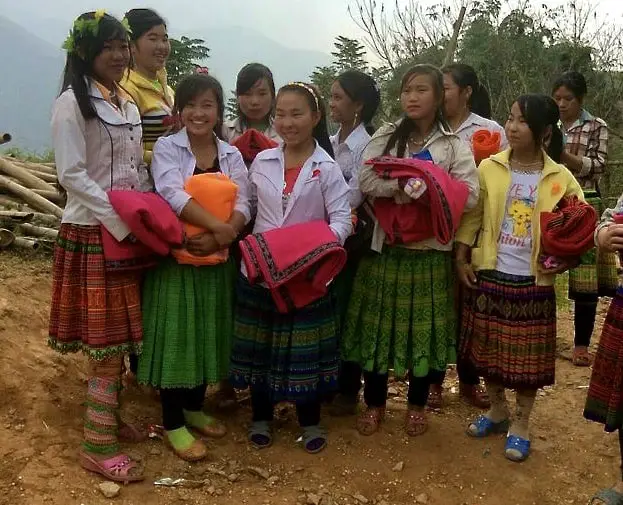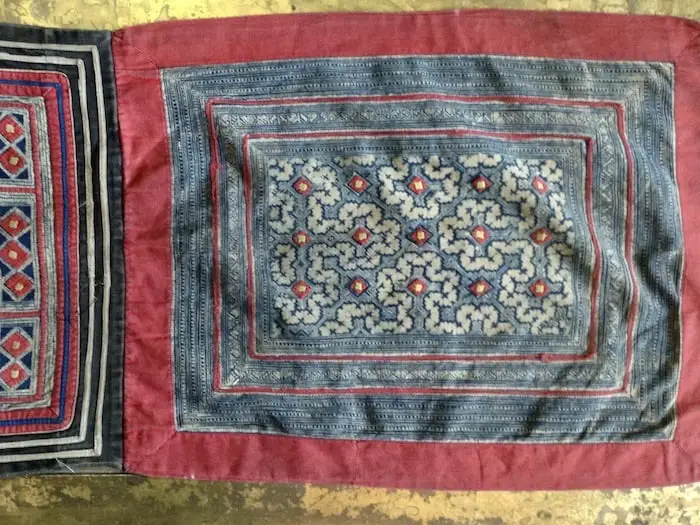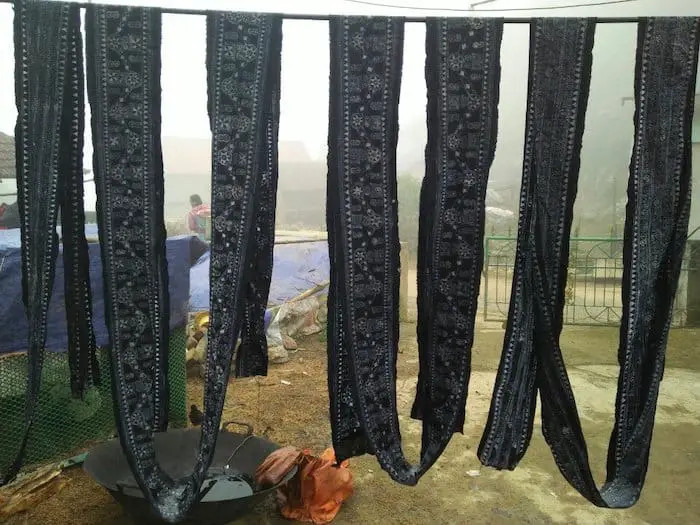In North Vietnam, many places in the mountains of North Vietnam make Batik Fabric as they have been producing it for hundreds of years. As you travel to parts of Northern Vietnam where many of the Hmong live, it can be common to see many Hmong girls with their traditional skirts that have batik fabric and embroidery on them.
Batik fabric is the process of putting a design on a piece of fabric by using wax. The fabric is then dyed, and the areas where the wax is put on the fabric will be left undyed, therefore leaving a pattern on the fabric. The Hmong in North Vietnam will use this technique for their traditional clothing. The Hmong batiks are also a great fabric for many Home Decor products as the Hmong use vibrant indigo dyes to make their batik fabric.
Table of Contents
- What is Batik?
- How is Batik Made?
- Hmong Hill Tribes and Batik Fabric
- How to Use Batik In Home Decor Product Development?
- Related Questions

What is Batik?
Batik is defined by the Oxford dictionary as:
“A method of colored designs on textiles by dyeing them, having first applied wax to the parts to be left undyed.”
Oxford dictionary
As the Oxford Dictionary states, batik fabric uses wax to put a design on a piece of fabric before the fabric is dyed. It is not a printing method but a method to apply the wax, usually by hand, to the fabric where the fabric will be left undyed.

How is Batik Made?
Making batik fabric is a handmade process and takes a lot of work and time. To be made properly, the artisans must have the proper training and skills.
Batik Fabric and Hemp Fabric
For traditional batik, the fabric is first woven by hand on a handloom. The fabric does not need to be woven by hand, but producing a truly traditional cloth will use handwoven fabric such as cotton or hemp. They may want to use hemp fabric because the natural color of hemp is more of a cream than a bright white color.
Another reason why hemp is used a lot for the Hmong batik fabric is that hemp is a crop that is locally available and cultivated, especially in North Vietnam. The crop is considered an important crop as it has a low environmental impact and can be grown and processed without any chemical treatments. A hemp crop can yield three times more raw fiber than cotton. This means that hemp is also considered to be an eco-friendly fabric and fiber.
Batik Tjanting (Canting) Tool
To produce Batik, you must have the correct tools, which are a Tjanting tool or also known as a canting tool. In Vietnam, the Tjanting tool has a wooden handle and a metal end with a rib where the melted wax can flow.
The tool’s idea is that the wax needs to be applied onto the fabric so that it will penetrate it enough so that the dye will not go into that part of the fabric. But the tool must also allow the artisan to lay the pattern out on the fabric properly.
Most Hmong Batik artisans will have several different Tjanting tools that can produce different lines or designs. Each one of these tools is used in specific ways to give a special effect to the batik design.
For these batik artisans, the tools they use are essential, and finding these tools is not always easy. The correct Tjanting tool can make the difference in the end product, and batik design looks, and how clear and clear the actual design is on the fabric.
How, where, and how much wax is put on the fabric can result in how the batik design will look. This is why the correct tool to apply the wax and the knowledge of applying the wax are very important.
Using Wax for the Batik Cloth
Batik is a reverse printing technique in that the wax will be put on the fabric in the place where you do not want to have the dye to go. The wax Hmong use is usually a combination of beeswax and candlewax.
The process of applying the wax to the fabric is extremely intricate. The batik artisan must think about the pattern itself and decide where they want to have the dyed parts located and do not want to have any dye showing.
This means that the pattern must be completely thought out or drawn out before any wax or design is put on the fabric. It can be difficult to correct part of the pattern once the wax is put on, as the wax, once dried, can only come off through heating and completely melting the wax.
The Dye Process
Once the cloth is completely covered in the pattern, then the wax must be completely dried before being dyed. The fabric is usually dyed with a large natural vat that contains some natural indigo dye. Today many of the producers will not use the natural indigo dye but will use a colorfast dye.
To get the true indigo color is not always easy. The cloth may need to be dipped several times to achieve this true dark blue-indigo color.
Today we see other colors than Indigo for the batik fabric. However, Indigo is the most common color and most widely used. We have seen some in some lighter blues, purple, and even orange.
Making a batik pattern and design is a real art form. Those who are very good at applying the pattern to the fabric literally spend a lifetime learning batik and refining their batik making skills. In the Hmong villages, batik is a craft and art form passed down from mother to daughter or literally from generation to generation.

Hmong Hill Tribes and Batik Fabric
In North Vietnam, one of the main producers of batik fabric is the Hmong. They use batik fabric on their traditional clothing, and in particular, the girls use batik on their beautiful Hmong skirts.
Many Hmong girls will spend a year preparing the Hmong skirt they will wear for the next year. This is because they will spin the yarns, weave the fabric, make the batik, and add the Hmong embroidery to their beautiful Hmong skirts. This is why for these homemade Hmong skirts, not only are each of them beautiful but they are also all unique works of art.
As the Hmong do not have a written language, they created symbols that would describe their surroundings. These symbols are used throughout their batik cloth patterns and designs and in their embroidery. Most of these symbols will have a meaning for things they see in their daily lives as mountains, snails, elephant feet, houses, chicken feet, or the sun.
But even though the Hmong will use these symbols in their traditional cloth, the batik process does not have to use traditional patterns. You can use this same technique for many other interesting patterns and designs,

How to Use Batik In Home Decor Product Development?
As blue continues to be a strong trend color for the home and fashion, batik fabric, as it uses mainly indigo and other blue colors, is a natural choice for home decor product development.
Here are some ways you can use the batik fabric for home decor product development:
- Pillow and Cushion Covers – One of the main ways batik can be used in home decor product development is pillow and cushion covers. You can use part of the batik for the pillow or make the entire pillow out of batik.
- Lampshades – Another way we use the batik fabric is on a lampshade. It can really add something wonderful to a lamp or even be used as a shade for a light.
- Screens – The fabric can be used in screens or other panels.
One of the great things about batik is that there are so many interesting ways to use home decor and product development. The fabric fabric is handmade has a rich history. It is an artisan handicraft that helps many marginalized women earn an extra income because we love batik so much and consider it a fabric that will be around for a long time.
Batik fabric is a great fabric to use for home decor product development. The fabrics usually have a rich indigo color, which is now one of the trends for this year. But more than that, you do not need to limit yourself to the traditional designs; we can do your own or other designs using the batik technique.
Find out more about how Mondoro can help you create, develop, and manufacture excellent home decor and furniture products – don’t hesitate to contact me, Anita. Check out my email by clicking here or become a part of our community and join our newsletter by clicking here.
Mondoro gives out a FREE Lookbook to anyone interested. You can receive a copy of our latest Lookbook by clicking here.
Listen to our Podcast called Global Trade Gal. You can find it on all major podcast platforms. Try out listening to one of our podcasts by clicking here.
Subscribe to our Mondoro Company Limited YouTube Channel with great videos and information by clicking here.
Related Questions
Who are the Hmong Hill Tribes?
The Hmong originally came from China, but during the late 18th Century, the Qing Dynasty started to push them out of China into many Chinese border areas. Today many of the Hmong live in the countries along the Chinese southern border. There are many groups of Hmong, but most of the Hmong today are farmers though many of them have recently started to be involved in the tourism industry.
To find out more about the Hmong you can read our blog entitled Hmong History, People and Culture by clicking here.
What Country Do the Hmong Come From? Hmong History, People And Culture
The Hmong originally came from China, but during the late 18th Century, the Qing Dynasty started to push them out of China into many Chinese border areas. Today many Hmong live in the countries along the southern Chinese border. There are many ethnic groups of Hmong. Most of the Hmong are farmers though many have recently started to be involved in the tourism industry.
You can learn more by reading What Country Do the Hmong Come From? Hmong History, People, And Culture by clicking here.


